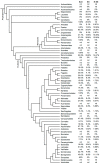The Distribution of Phytoecdysteroids among Terrestrial Vascular Plants: A Comparison of Two Databases and Discussion of the Implications for Plant/Insect Interactions and Plant Protection
- PMID: 36840124
- PMCID: PMC9967490
- DOI: 10.3390/plants12040776
The Distribution of Phytoecdysteroids among Terrestrial Vascular Plants: A Comparison of Two Databases and Discussion of the Implications for Plant/Insect Interactions and Plant Protection
Abstract
Phytoecdysteroids are a class of plant secondary compounds which are present in a wide diversity of vascular plant species, where they contribute to a reduction in invertebrate predation. Over the past 55 years, a significant body of heterogeneous literature on the presence, identities and/or quantities of ecdysteroids in plant species has accumulated, resulting in the compilation of a first database, the Ecdybase Literature Survey (ELS; 4908 entries, covering 2842 species). A second extensive database on the distribution of ecdysteroids in vascular plants is available as the Exeter Survey (ES; 4540 entries, covering 4155 species), which used standardised extraction and analysis methods to survey seeds/spores. We compare the usefulness of these two databases to provide information on the occurrence of phytoecdysteroids at the order/family levels in relation to the recent molecular classifications of gymnosperms, pteridophytes/lycophytes and angiosperms. The study, in conjunction with the other published literature, provides insights into the distribution of phytoecdysteroids in the plant world, their role in plant protection in nature and their potential future contribution to crop protection. Furthermore, it will assist future investigations in the chemotaxonomy of phytoecdysteroids and other classes of plant secondary compounds.
Keywords: 20-hydroxecdysone; Ecdybase; chemotaxonomy; ecdysone; ecdysteroids; molecular systematics.
Conflict of interest statement
The authors have no conflicting interests to declare.
Figures



References
-
- Christenhusz M.J.M., Byng J.W. The number of known plant species in the world and its annual increase. Phytotaxa. 2016;261:201–217. doi: 10.11646/phytotaxa.261.3.1. - DOI
-
- Antonelli A., Fry C., Smith R.J., Simmonds M.S.J., Kersey P.J., Pritchard H.W., Abbo M.S., Acedo C., Adams J., Ainsworth A.M., et al. Royal Botanic Gardens; Kew, UK: 2020. State of the World’s Plants and Fungi. - DOI
-
- Nakanishi K., Koreeda M., Sasaki S., Chang M.L., Hsu H.Y. Insect hormones. The structure of ponasterone A, an insect-moulting hormone from the leaves of Podocarpus nakaii Hay. J. Chem. Soc. Chem. Commun. 1966;24:915–917. doi: 10.1039/c19660000915. - DOI
-
- Galbraith M.N., Horn D.H.S. An insect-moulting hormone from a plant. J. Chem. Soc. Chem. Commun. 1966;24:905–906. doi: 10.1039/c19660000905. - DOI
LinkOut - more resources
Full Text Sources
Miscellaneous

